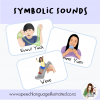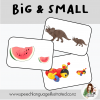Early Verbs
NZD 13.99
Description
Description:
Verbs are central to sentence construction. To progress past the 1-2 word level of communication (e.g. ball, my ball), you need verbs. Verbs can be difficult things to understand and teach for several different reasons which are outlined in this product. If a child is experiencing difficulties with language, it is likely they will have a reduced repertoire of verbs.
This resource contains 64 illustrated verb cards which are labelled and grouped by their Semantic Meaning Relation categories, in approximate sequence of development as identified in the Bristol Language Study. This ensures that a wide variety of verbs needed to communicate in daily interactions are included. The majority of the verbs included are were also identified as early occurring forms by Dale and Fenson (1996). Both “core” verbs such as want, eat, go, put, do, get, etc are included, along with more specific verbs such as swim, climb, pat, and jump.
The importance of interaction, explicit teaching, and repetition with variety are highlighted in this resource. All verb cards included are double sided, with several ideas of how to model the verb, and create lessons around the verb in the home. Parent information pages are also provided for: Why we teach verbs, how we can be effective in teaching verbs, ideas on how to use the cards provided, and ideas on how to use the cards to target additional goals such as articles, pronouns, grammar and early sentence construction.
The verb cards have yellow borders to align with the Colourful Semantics approach, and narrative resources from the Blacksheep Press.
This product is ideal for use in regular therapy sessions as well as home programmes.Verbs are central to sentence construction. To progress past the 1-2 word level of communication (e.g. ball, my ball), you need verbs. Verbs can be difficult things to understand and teach for several different reasons which are outlined in this product. If a child is experiencing difficulties with language, it is likely they will have a reduced repertoire of verbs.
This resource contains 64 illustrated verb cards which are labelled and grouped by their Semantic Meaning Relation categories, in approximate sequence of development as identified in the Bristol Language Study. This ensures that a wide variety of verbs needed to communicate in daily interactions are included. The majority of the verbs included are were also identified as early occurring forms by Dale and Fenson (1996). Both “core” verbs such as want, eat, go, put, do, get, etc are included, along with more specific verbs such as swim, climb, pat, and jump.
The importance of interaction, explicit teaching, and repetition with variety are highlighted in this resource. All verb cards included are double sided, with several ideas of how to model the verb, and create lessons around the verb in the home. Parent information pages are also provided for: Why we teach verbs, how we can be effective in teaching verbs, ideas on how to use the cards provided, and ideas on how to use the cards to target additional goals such as articles, pronouns, grammar and early sentence construction.
The verb cards have yellow borders to align with the Colourful Semantics approach, and narrative resources from the Blacksheep Press.
This product is ideal for use in regular therapy sessions as well as home programmes.
Product Includes:
- 64 verb cards, with ideas for targeting the verb in natural environments on the reverse
- Handouts on teaching verbs
Format: PDF
Pages: 38
You must be logged in to post a review.

















Reviews
There are no reviews yet.